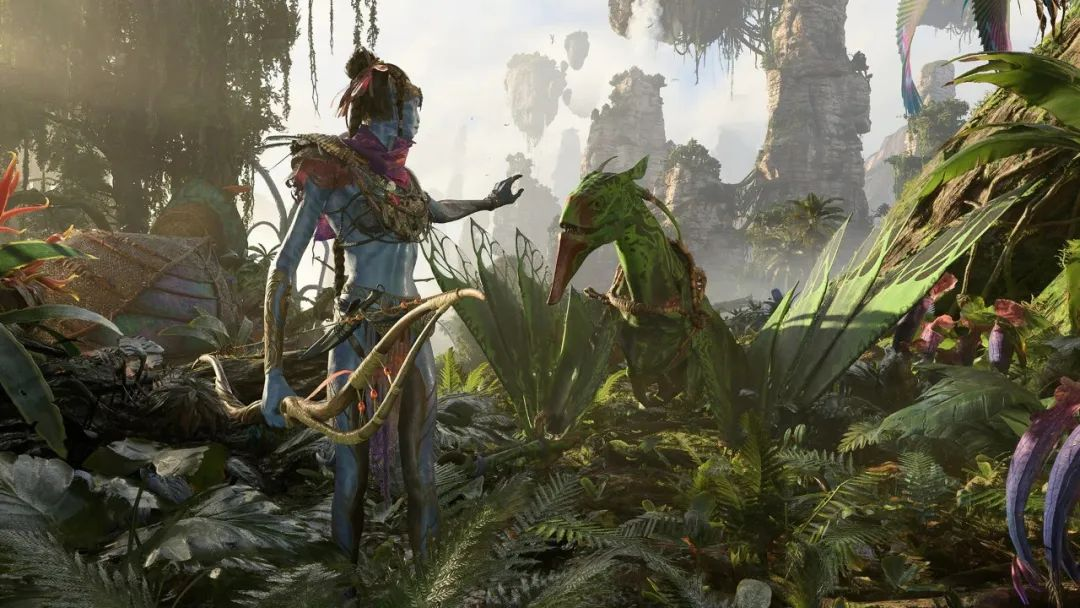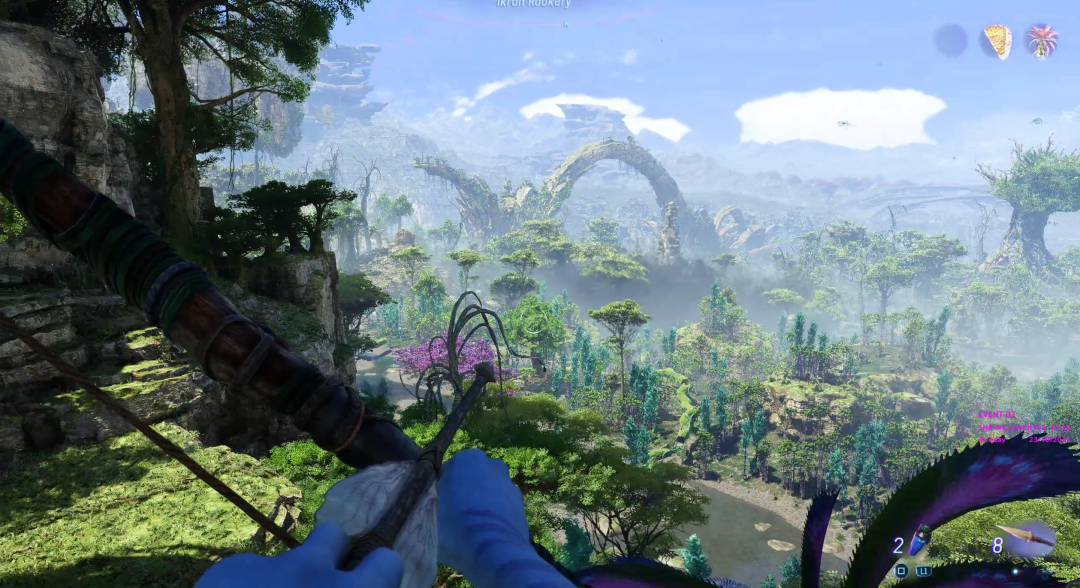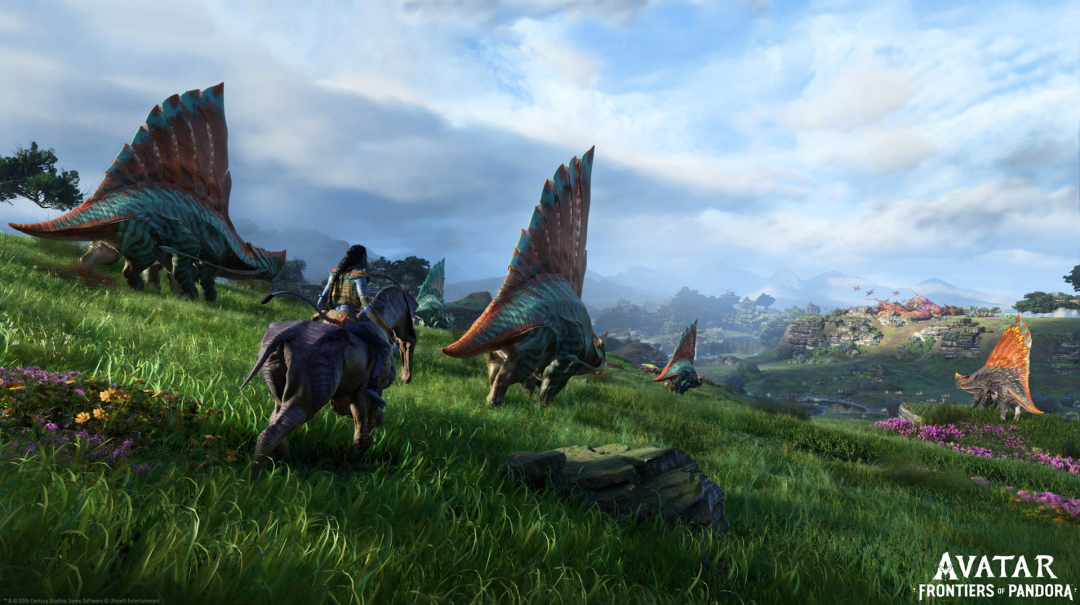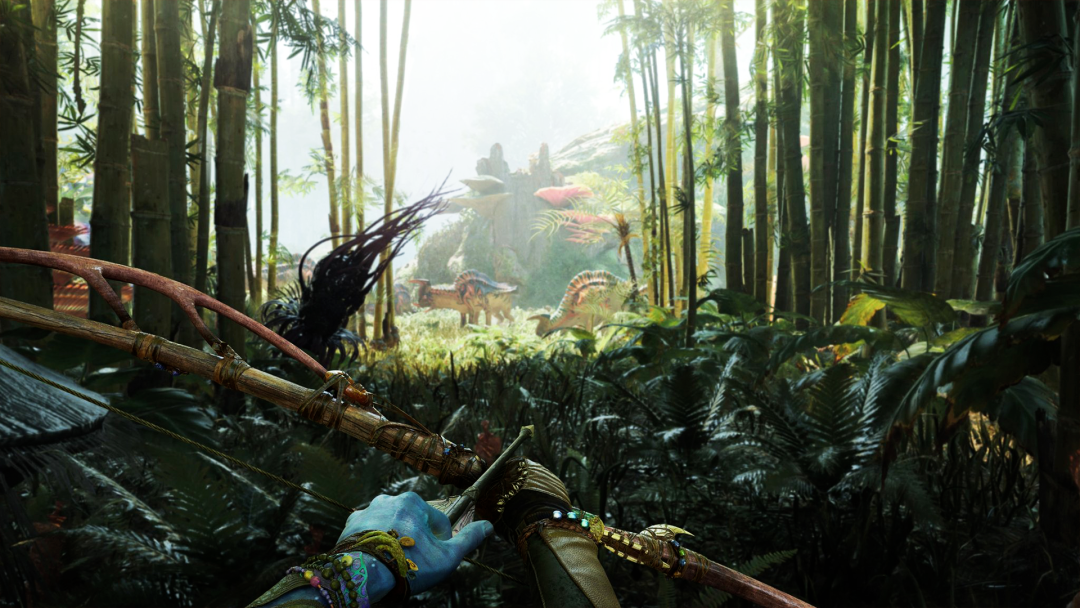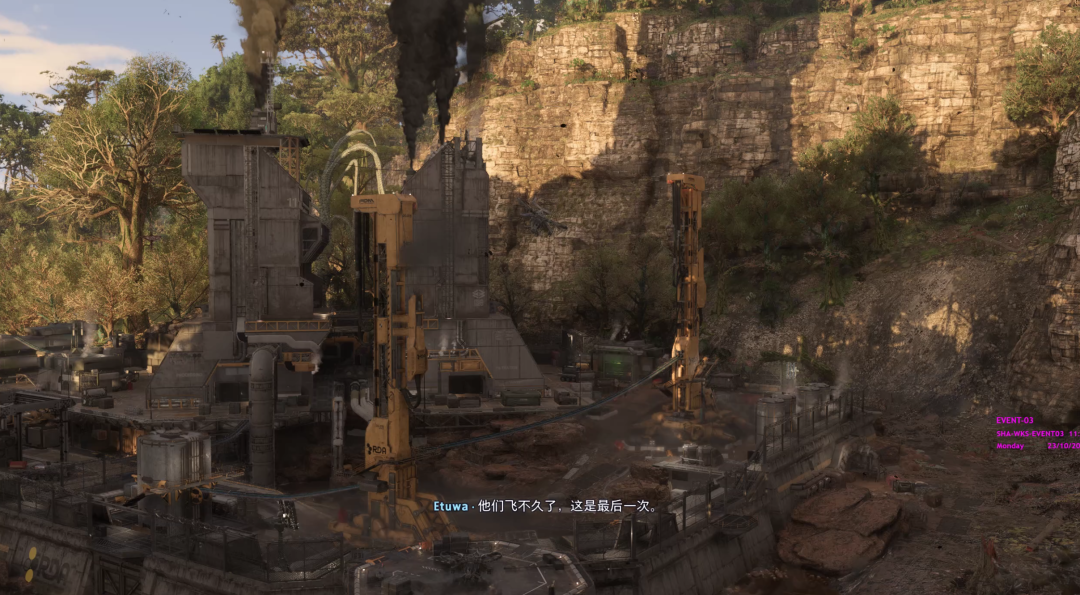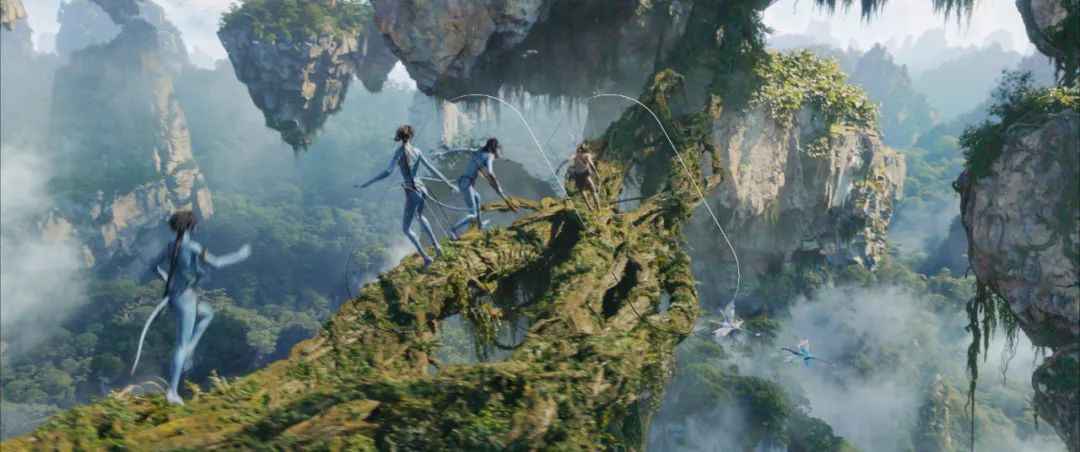In Pandora's Frontier, Ubisoft wants to be the "Cameron" of the gaming world
In Pandora’s Frontier, Ubisoft wants to be the “Cameron” of the gaming world
Burrowing out of the cave, plucking banana leaves and climbing up the waterfall and vines, the bouncy giant purple flower bounces me into the air. The flying arrow in my hand shoots out and penetrates the peculiar plant shaped like a pumpkin, which spits out the long stem in its belly and creates a treacherous and reluctant pathway up the wall. The lilting melody of harp flutes and African drums echoed in my ears, and behind me was a stunning view of lush greenery and unobstructed views.
But I can’t take it all in - it’s 10,000 feet in the air, with mines of all sizes floating in the air due to superconductivity, connected only by roots and vines, and with every step, the mental tension of fear of heights deepens. It was then that I remembered the chief’s last words of advice before we set out:
“My dear, we hunters always say, “Don’t look down,” and you’d do well to remember the lessons of your predecessors.”
In the 2009 Avatar movie, Jack, a human spy who becomes an avatar, climbs up to the Ikran habitat on Pandora in order to get his own “pterodactyl”. It’s the climactic moment of the movie, with boulders floating in the clouds; Ikaram weaving through waterfalls; and the protagonist, palms sweating, climbing up a vine at a height of 10,000 feet with no place to land. And 14 years later, I experienced a similar process immersed in a first-person perspective in the medium of gaming.
And this time, it struck me as deeply as the movie did back then.
The first PV for Avatar: Pandora’s Frontier
Two years ago, Ubisoft released the first PV for Avatar: Pandora’s Frontier at E3. it was the grand finale of Ubisoft’s conference that year and was announced by the company’s founder, Yves Guillemot, himself.
The most impressive thing about the PV is the “graphic upgrade” that Yves Guillemot emphasized, and every frame in the PV is comparable to CG, with the daylight at dusk hitting every inch of Pandora’s new vegetation in an extremely natural way. In the natural and harmonious rainforest of Pandora, every flower, tree, shrub, and grass is swaying in the wind as if it were conscious. The art resources in the entire PV are incredibly high-definition and intensive.
On B-site, this teaser trailer has received millions of plays, with more skepticism in the pop-ups than praise and amazement. As Ubisoft’s last generation has a lot of “shrinking history”, this trailer is also reasonably suspected by a large number of players as “false propaganda”. Pandora’s dense vegetation, in particular, looks like a movie effect. However, common sense would tell us that the effect is not as bad as the movie effects.
However, common sense tells us that it is virtually impossible to achieve movie-quality real-time rendering in the game with common civilian-grade graphics cards.
- The first PV of what has been described as “false advertising”
In most cases, the use of “paper grass”, “paper leaves”, supplemented by high contrast lighting, to reduce the physical interaction between the environment and the player, and the addition of brightly colored filters, to create a seemingly “natural” atmosphere, is the only way to achieve a “natural” atmosphere. “This is a common pattern in modern game design. Whether it’s Soul of Tsushima, which is known for its atmosphere, the technically top-notch Ultimate Horizon 5, or the medieval wilderness of Skyrim: Salvation, which is close to reality, none of them have gone beyond this framework. I remember telling my coworkers who were up all night with me, with the confidence of common sense, “It’s definitely CG!
If I hadn’t tried Pandora’s Frontier myself, I’d probably still think that today.
- The PV demo’s vegetation effects are “fake at first glance”
But the Ubisoft CEO wasn’t lying. The demo of Pandora’s Frontier has been scaled back a bit in terms of special effects and mechanical modeling compared to the questionable “in-engine” demo from two years ago. Other than that, the rest of the game is almost identical to the PV, with the density of the environments in the demo remaining intact, and individually modeled natural vegetation in a variety of colors as far as the eye can see. The environments are richly layered, from moss and grass at the bottom, to shrubs and vines on top, to sycamores, trees, and even giant crowns, all of which blend together in a way that is at the level of many “engine showcase demos”.
Importantly, the texture of the whole “nature” is also largely due to the interactivity of the ecology.
Much like the Avatar movies, the Na’vi, who live in harmony with the planet’s mother goddess, Ava, have always insisted on “taking what comes from nature”. Fruits in the game can be harvested, and depending on the time of year and the skill level of the picker, the harvested fruits will have very different qualities. Stiff stalks of grass can be used to make arrows, and burnt bird eggs can increase your movement speed. Breaking a pumpkin-like barnacle will provide a climbing rope, and inhaling a special pollen will increase your blood level for a long time. While it’s not quite Star Citizen-level “everything is animated,” there are far more interactive scripts than in previous Ubisoft games.
The content is still limited to visual effects, but the immersion brought about by the “technological explosion” that took place as I delved into the Pandora rainforest and pressed up against countless patches of thick, textured, interactive, physically-detailed grasses and stalks made a qualitative difference to the experience - everywhere I went, I was in the middle of the action, and everywhere I went, I was in the middle of the action. -Wherever I go, I am in the world of the movie.
Explore the world, fight in strongholds
In contrast to the graphical breakthroughs, Pandora’s Frontier’s gameplay framework remains true to Ubisoft’s “traditional model”. Explore the world, fight in strongholds, and complete one main and side mission after another. Open the map and the mission menu, arrive at the location and start watching the movie.
The plot is also quite traditional, with the player being a native Na’vi, who for some reason was taken away from the human race at a young age and raised away from his tribe. Although he has established a deep connection with the human world, as he grows older, he becomes more aware of his own race and the human invasion of Pandora. Eventually, he decides to rejoin his tribe and lead them in a revolt.
That’s right, the game opted for an original plot, with a timeline between Avatar 1 and 2, and since the game is in first-person throughout, combined with the traditional plot of fighting strongholds and “rebelling against tyranny,” it’s very reminiscent of the Crysis series.
- Fighting strongholds, familiar?
But as mentioned before, even if everything is familiar, most of the game’s formulaic content is “lubricated” by detailed animations, rich dialog, and significantly improved motion capture performances, thanks to the sheer number of scripts and art assets.
Approach an ordinary stronghold at random and you’ll receive a “dialog narration” that fits the current plot. Passing by a plane crash site, the system will remind you of a side quest that requires you to use “connect-the-dots” to piece together objects scattered in the environment, deduce the truth of the accident, and complete an “environmental narrative”.
From a practical standpoint, this “piling up” of Ubisoft’s “canned” garbage time still didn’t prevent me from fast-forwarding through the side conversations, but at least it made me happy to stop and finish one of the “canned” dialogs on my way to the main event. “Canned” quests, checking out the details of the world.
Obviously, Ubisoft is aware of the fact that contemporary gamers are tired of “canned” games, so they came up with the ultimate idea of adding more flavor to the can. And after tasting it, I’ll admit it works.
The Living World
At the end of the demo, I asked Pandora’s Frontier project producer Alain Gurniki some questions during the media interview session. In his answers about the gameplay, the producer informed me that the most central creative concept of the entire project is - “The Living World”.
Alain Gurniki told me that Pandora is a breathing, conscious planet, and that the Na’vi, as the “chief of all spirits”, interact with it all the time. So in terms of gameplay, they needed to present a realistic, detailed, and at the same time complete ecological world, which is unprecedented in the whole game field.
In my two-hour demo, I saw carnivorous wolves hunting in the wild, grass and trees shrinking as the protagonist moved closer and closer, and my own Ikaran creeping through the trees of his home and playing with the birds around him. I don’t know if this is what Alain Gurniki would call an “eco-world,” but even if it’s not “unprecedented,” it’s at least refreshing and deepens my impression of the world over and over again.
Since Pandora’s Frontier was developed in real time and reviewed by Disney and Cameron’s Lightstorm team, the game’s vegetation and ecological effects all follow the basics of Pandora’s planet. In the technical realization of the link, also need to go through the Cameron style “fault-finding” and polishing and upgrading.
For example, the upgraded “Snow Lotus Engine” can achieve geometric high-density optimization of art assets. Dynamic weather brings wind physics, water physics, temperature and humidity of the water apparatus can be visualized, Pandora’s unique vegetation fluorescence can rise and fall in brightness according to the time of day, and even the pupil scaling of living creatures can be simulated in real time.
As I talked to the producers about these almost “black-tech” effects, I recalled over and over again how amazing I felt when I saw Avatar for the first time in 2009.
At that time, Cameron was already one of the most prestigious directors in the movie industry, and he was obsessed with special effects technology in the movie field. The hope was to make a never-before-seen sci-fi movie, Avatar, using 3D and CGI technology throughout.
Before the release of Avatar, 3D movies have appeared, but due to the cost of production, the degree of technical realization and other issues, resulting in the use of technology in the finished film is mostly rough, vertigo, nausea and headaches are also difficult to resolve. Hollywood movie industry will be regarded as a failure of the technology chicken ribs, snowed for many years, “Avatar” also naturally become unpopular against the tide of work.
Then Avatar hit the box office myth, raking in $2.9 billion. It became so famous worldwide that in my small, third-tier town, the only movie theater in town had a full month’s worth of screenings. Avatar was also the first 3D movie I ever saw in my life.
- Avatar was not well received by the industry.
So in my memory, 3D was not just a failed technological cock-up, but a huge step forward in the history of cinematic art. Cameron gave a young amateur movie fan and a seasoned and experienced Hollywood producer completely opposite perceptions, and proved the former right in the future.
With the framework of the gameplay unchanged, what exactly is the point of making the florals clear? If you were reading the previous content and had the same questions that I had when I first got into the game? Then let’s go back to the beginning of the article.
As I traveled through the jungle, plucking leaves and vines, I climbed to the highest point, and at the end of the quest, I tamed the Ikaran that belonged to me, naming him “STROM”. A hunter-guide pushed me off a cliff, called out its name as I plummeted, then swooped and soared to the sound of rousing vocals, riding the winds and enjoying the lush beauty of the world 10,000 meters away. The emotional experience, like the climax of the ‘09 movie, scurries up above the clouds where the Ikaran shuttle soars, and perhaps the answer is found.
Maybe this time, Ubisoft wants to be the Cameron of gaming.
